Modern Cryptocurrency With A Price of Gold
StableCoin Gold is a smart contract with an admin dashboard, designed to provide users with real-time insights and better control over token management. The admin dashboard includes up-to-date information on the token’s current value, based on the current price of 1 gram of gold, the status of the liquidity pool, and a breakdown of the funds and tokens available within that pool.
Who Can Use StableCoinGold
The target audience of StableCoin Gold is investors who plan to diversify their portfolios, as well as anyone who can own cryptocurrency. StableCoin Gold is designed for both experienced users and newcomers seeking reliable and convenient ways to invest in cryptocurrency.
What Did The Client Come To Us With?
The client requested a stablecoin development that would be tied to the price of gold. They had only a white paper, so we had to prepare technical documentation for them.
Project’s First Preparations And Estimations
At the early stage of the project, we outlined the core functionality and strategic goals. We also clarified the overall scope of the project and aligned expectations with current business goals. Then we discussed the methods of smart contract development and its structure. Our team also considered the project logic formation and chose a platform for liquidity pool development.
We also planned an admin dashboard and a smart contract infrastructure development to support the platform’s operations. Before starting backend development, we chose the standard for the smart contract and the type of cryptocurrency (StableCoin). The price of stablecoin is regulated by a blockchain oracle, ensuring transparency and consistency in valuation.
Project manager, a QA tester, and two developers were involved in StableCoin Gold development. One of them has strong experience with blockchain and previously worked with URCTRL, which also utilizes cryptocurrency.
Overall, we estimated that the whole project development would take about 280 hours.
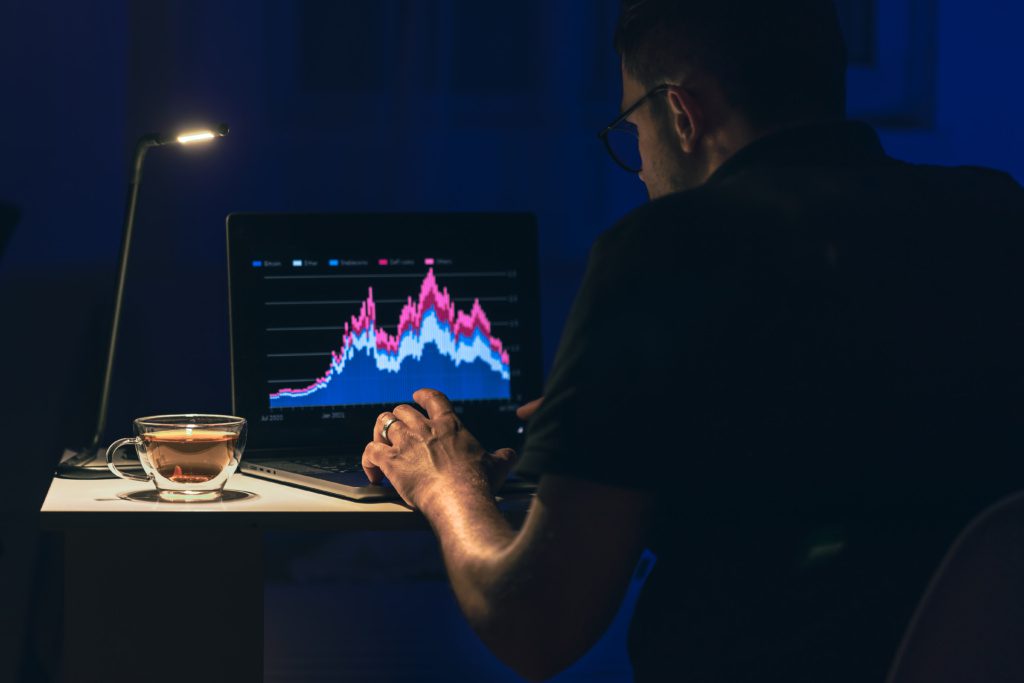
Keeping in Contact with a Client
We were using Slack to communicate with a client. We update our clients with reports every day, and calls with the client were made as needed and requested by the client. Discussions were held with a client at least once a week, where we introduced new features and functions.
Technologies We Chose
For the client’s request, we used the Ethereum network for blockchain. Our team also chose Vue.js for dashboard development – a technology we have strong experience with. Then, we used Solidity with ERC-20 protocol (it defines Ethereum token issuance rules) to write smart contract, Ether.js for smart contract interaction with the platform, and Uniswap v3, ApeSpace, and Gecko Terminal for liquidity pool development. Last but not least, we chose METAMask and Trust Plus for digital wallets.

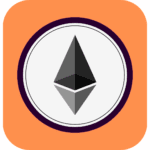






Description of the Development
Learn More About Cryptocurrency Regulations
At the beginning, we thoroughly explored regulatory documents like the ERC-20 standard, a general blockchain list of recommendations to increase the legitimacy of a token. ERC-20 is a set of basic precautions that should protect token owners and the audience from potential and obvious fraudulent actions by smart contract creators. For example, the standard includes a ban on a smart contract from burning tokens in other people’s wallets without notifying the owner of this wallet.
Last but not least, we learned more about US law, its specifics, and prohibitions.
Smart Contract Architecture
Our developer wrote the smart contract logic and a set of methods implemented with these tokens. Then, he developed an admin panel and integrated the template. The next step of development was writing the interaction between the admin and the smart contract so it could work inside the contract by pressing the button on the panel.

StableCoin Smart Contract Verification
For our client’s project, we did contract verification. This was done so that exchanges could make sure the smart contract doesn’t contain any pitfalls. After the contract’s verification, a user can do whatever they want with the bought coins.
We also made the stablecoin available on most exchanges. A user creates and submits applications and information about themself. Then they prepare due diligence papers, and the legal structure checks them and issues its expert guarantee that the user is not a fraudster and does not launder money.
Maintaining Token’s Price
We have developed the algorithm for maintaining the price relative to gold work more precisely and subtly. We can choose the level of sensitivity of the algorithm to price fluctuations. Additional work consisted in ensuring that the price binding was carried out completely without any action on the part of the client.
Eventually, we made the website display the price of the token plus $10 so that users can earn on top of it. We also attached a form to the website that would allow them to create an application so that third-party clients could buy stablecoin from the owner through their website, and not through the blockchain. Plus, to increase the token’s trustt among the general audience, we submitted applications to aggregators and personal exchanges to create the social capital of the token.
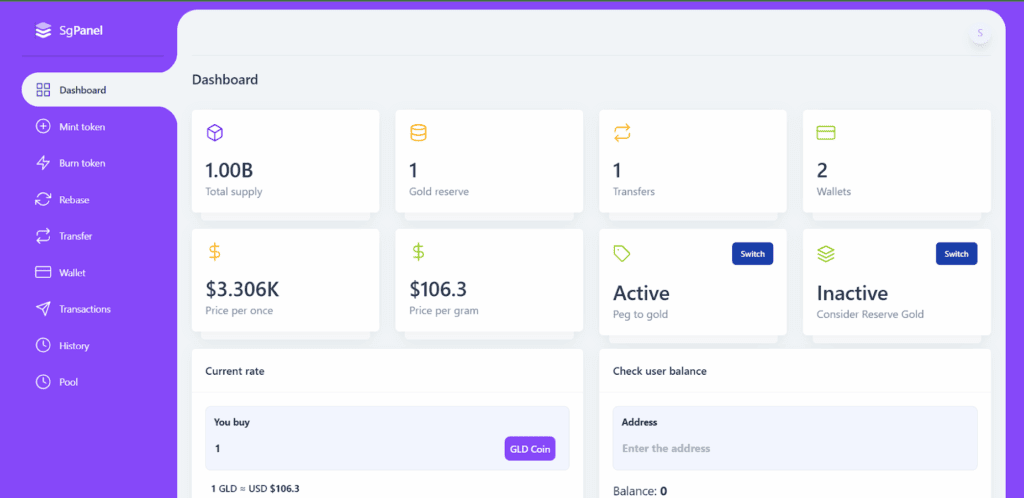
StableCoin Gold dashboard description from left to right, top row:
- The number of created tokens (not necessarily in circulation),
- General number of transactions with the token across the whole blockchain;
- The number of token holders;
- The token price based on an ounce of gold, provided by the blockchain oracle;
- The token price based on a gramm of gold, provided by bthe lockchain oracle;
- The two last windows which show active/inactive status of price support algorhitm.
Mainnet and Testnet
Our team carried out the entire development process in the mainnet and testnet in a few steps. First, the developer writes a smart contract, then deploys it to the test network. Then, the tester checked the functions for the smart contract to see whether transactions are successful and whether the restrictions work.
After that, the contract is deployed to the mainnet, and becomes available to the whole world, and connects to the admin panel. We also tested the admin dashboard other functions such as compression, burning, creation, maintaining balance, enabling it to be oriented to the gold price, disabling it, and adding tokens and money to the pool.
Liquidity Pool Development
We added a liquidity pool to the project so that the algorithm would track how much the current price of our stablecoin differs from the price of gold on blockchain oracle. So, based on the mechanism of market supply and demand, the token approaches this very price on the exchange. With the platform implementation, a user can carry out all purchase and sale transactions.
The developers team also conducted additional work to make the stablecoin available for indexing on exchanges and aggregators that browse and scan the blockchain for any new tokens, and actually give some other users the opportunity to track the schedule, behavior, and, in principle, the state of this token.
Connecting Third-Party Services
We introduced Gecko Terminal and ApeSpace for StableCoin Gold, and each platform has its own purpose. Gecko Terminal, for example, tracks prices, trading volumes, liquidity, and the number of transactions on dozens of blockchains in real time. ApeSpace, in turn, serves as a platform for the liquidity pool.
We also made a button on the site for users to connect and receive tokens, through their WEB wallets in MetaMask and TrustPlus.
How Web Visuals Were Created
Even though the smart contract itself is mostly a backend, the client already provided us with the design of the admin dashboard. We deployed the given template on the server, and then the clients provided a very general design based on the color scheme and the approximate arrangement of the elements.
The Main Challenges of Project Development
Development difficulties arose with working on interaction with wallets, because the services that provide wallets are third parties, and we have a limited influence on how they show our token. For example, the METAMask wallet couldn’t display the cost of our token. And so far, our token has low social capital, so each transaction to user wallets requires confirmation that the user knows about accepting some unverified cryptocurrence and takes responsibility for what happens to it.
There were also technical issues with payment control – wallets weren’t confirming the transactions, the automatic addition and subtraction of money and tokens. Luckily, our developers successfully fixed this issue.
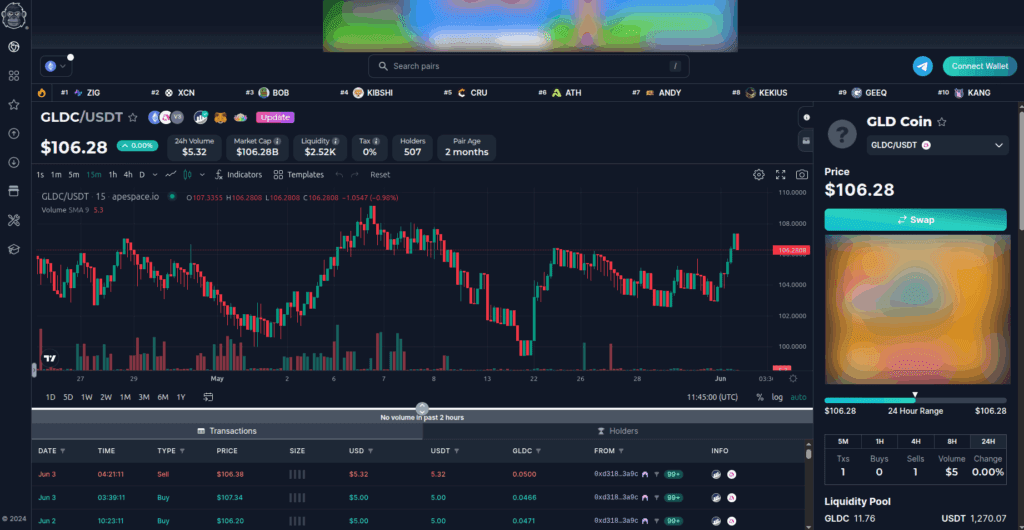
What Was The Final Solution
Stable Coin Gold is a smart contract with an admin dashboard that allows our client to receive more timely information and manage tokens. The dashboard displays the current prices for our token per gram of gold, liquidity pool and how much money and tokens are in this liquidity pool. The stablecoin also has another small dashboard with transaction history, wallet addresses, and a list of actions.
After a client’s wallet is tied to a platform, they can provide financial transactions, and each transaction in the blockchain costs a certain amount of money. A client keeps their funds, pay for each transaction of adding and subtracting tokens, and adding or subtracting money. And this project also have an algorithm to support the price of gold by making small trades. Every minute, it checks the difference between the price of gold and the price of the token. And either sells or buys a certain number of tokens to balance it in one direction or another.
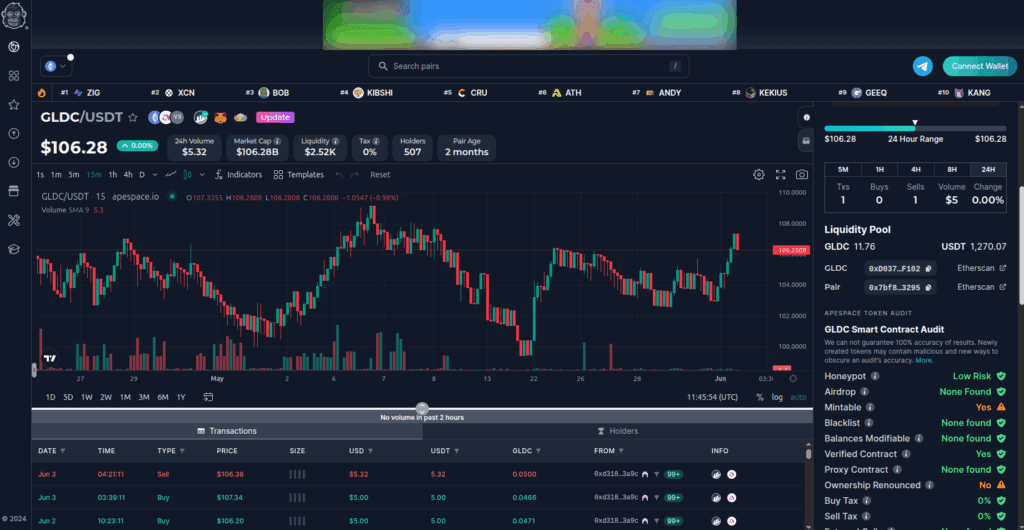
In this project, a client can create tokens, send them to the dashboard, other addresses, and burn them. A client can also enable and disable the binding to the price. Again, the dashboard has an algorithm to bind to the price, to gold, and if gold has become more expensive than the token, a user adds money to the liquidity pool, or reduces the number of tokens, making them more expensive or cheaper. The token’s price depends on how a user manipulates these two variables – the number of tokens and money.
Current status
The main functionality is complete and has been launched live. This cryptocurrency also already exists and is available for use. The client has ordered additional work regarding the upgrade of this project.

